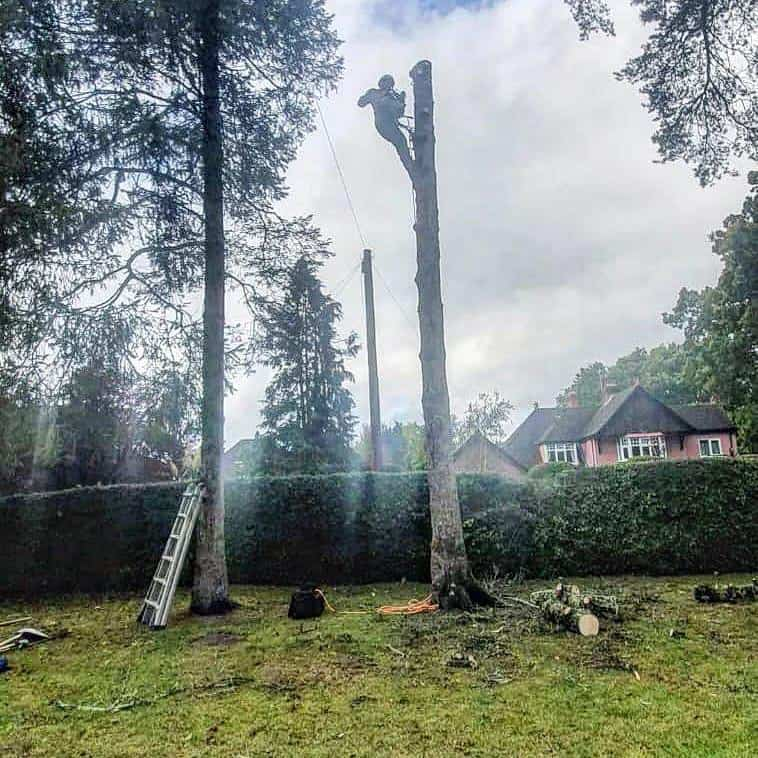Introduction
Tree stump removal is an essential part of maintaining a tidy and safe outdoor space. While stump grinding is often an efficient solution, some stumps require multiple grinding sessions to be fully removed. Various factors, such as the tree species, root structure, and stump size, can make complete removal more challenging than expected.
At NS Tree Surgery Caterham, we specialise in professional stump grinding services in Caterham, Surrey, ensuring that unwanted stumps are dealt with effectively. This article explores why certain stumps need multiple grinding sessions and what homeowners can expect from the process.
Key Takeaways
- Large or deep-rooted stumps often require multiple grinding sessions.
- Some tree species have more complex root systems, making removal more difficult.
- Stumps in hard-to-reach areas may require careful, staged grinding.
- Soil conditions and underground obstructions can impact the efficiency of stump removal.
- Professional stump grinding ensures complete removal while minimising landscape disruption.
Factors That Influence the Need for Multiple Grinding Sessions
1. Tree Species and Wood Density
Different tree species have varying wood densities, affecting how easily a stump can be ground down. Hardwood trees such as oak, beech, and maple have denser wood, requiring more time and effort compared to softer species like willow or poplar.
Why it matters:
- Hardwoods take longer to grind and may require multiple passes.
- Some species have deep or widespread root systems that make complete grinding more complex.
- Certain trees produce tough, fibrous wood that resists grinding, requiring additional sessions.
2. Stump Size and Depth
The larger the stump, the more material there is to grind away. Additionally, some stumps extend deeper into the ground, making it harder to remove all remnants in a single session.
Challenges with large stumps:
- More grinding is needed to reach the entire depth of the stump.
- Wider stumps may require repositioning of the grinder multiple times.
- Deep root systems can require additional effort to ensure complete removal.
3. Location and Accessibility
Stumps that are located in difficult-to-reach areas, such as near fences, walls, or other structures, can pose challenges during grinding. Limited access may require careful, staged grinding to avoid damage to surrounding areas.
How location affects grinding:
- Stumps near obstacles may require multiple sessions to safely remove layers without causing damage.
- Narrow spaces may restrict the movement of stump grinding machinery, necessitating incremental grinding.
- Urban or landscaped areas may require a more cautious approach to protect surrounding plants and pathways.
4. Soil Conditions and Underground Obstructions
The composition of the soil around a stump can impact the grinding process. Hard, compacted soil or rocky ground can slow down grinding, while underground utilities, pipes, or old building foundations may require adjustments to the grinding method.
How soil conditions affect stump grinding:
- Rocky soil can damage grinding equipment, requiring more careful and staged grinding.
- Clay-heavy soil may cause grinding debris to compact, making removal more difficult.
- Underground pipes or cables may limit how deep grinding can go, requiring additional sessions to work around obstacles safely.
The Multi-Session Grinding Process
1. Initial Grinding Pass
The first grinding session focuses on removing the bulk of the stump, typically grinding it down to a few inches below ground level. This stage helps break down the main structure of the stump and exposes the root system.
2. Secondary Grinding for Deep Roots
If the stump is large, has deep roots, or is made of dense wood, a second session is often required to grind the remaining portions further below the soil surface. This ensures that regrowth is prevented and the area can be repurposed effectively.
3. Final Levelling and Site Cleanup
Once grinding is complete, the remaining wood chips and debris are cleared away. In some cases, additional grinding may be necessary to ensure the area is levelled properly for landscaping, turf laying, or replanting.
At NS Tree Surgery Caterham, we provide thorough stump grinding services in Caterham, Surrey, ensuring that stumps are fully removed with minimal disruption to your outdoor space.
Conclusion
While many stumps can be removed in a single grinding session, some require multiple passes due to factors such as tree species, stump size, location, and soil conditions. Understanding these challenges helps homeowners set realistic expectations for the stump removal process. By working with professional tree surgeons, you can ensure that even the most stubborn stumps are effectively removed.
For expert stump grinding services in Caterham, Surrey, NS Tree Surgery Caterham provides professional solutions tailored to your property’s needs. Contact us today to schedule a consultation and restore your outdoor space.
Call us on: 01883 771 495
Click here to find out more about NS Tree Surgery Caterham
Click here to complete our contact form and see how we can help with your tree needs.

